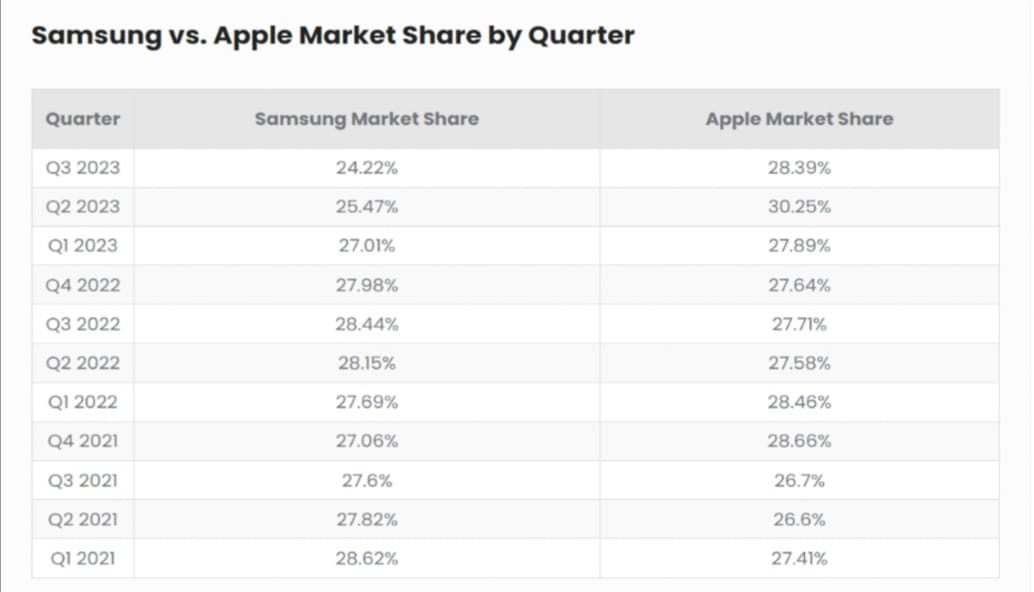Apple vs Samsung: An Endless Saga of Tech Rivalry
Apple vs Samsung: An endless saga of tech rivalry
Introduction:
You might have often come across the classic internet controversy “Which is better? Samsung or Apple’’.
The intense rivalry between the world’s leading smartphone companies Apple and Samsung is quite evident, with both the companies competing for the dominance in the market. The sheer competition between the two brands has proven to be a catalyst to innovation in technology and marketing strategies over the years. Who really takes the throne? The answer to this remains unknown. This blog post aims to explore the competition between Apple Inc. and Samsung in the smartphone industry.
How it all began
It all dates back to 2007 when Apple launched its first smartphone device, the original iPhone, creating a stir in the market. It was not until 2009 when Samsung entered this market unveiling its own smartphone ‘Samsung GT-I7500 Galaxy’. Although multiple firms introduced their own smartphone devices, Apple and Samsung continued to top the ever-increasing market scene.
A dive into their market performance
Both firm’s sales graph follows a defined trend each year since they have set annual launch schedule for their smartphones- Apple launches in the last quarter of the year while Samsung releases in the first quarter.
From the above table, it can be seen that over the past two years, a stiff competition prevails between Samsung and Apple, with both having almost equal share in the market, taking over almost 50% of the global market share.
In 2022, Apple’s revenue was $394 million dollars. In the same year, the iPhone sales alone recorded over $205 billion, accounting for over 52% of the total net sales.
While Samsung generated around $234 million dollars as revenue in 2022, with its mobile phones being responsible for 21% of the company’s operating profit.
A look into their business strategies.
Samsung’s business plan thrives on
boosting production volume, vertical integration of supply chains, diversifying its product offerings (electronic gadgets and services) to a worldwide consumer base. From mid-range to high-end products, Samsung provides a plethora of options to its customers, making its products affordable.
Apple, on the other hand prioritizes design and overall user experience, constant innovation, exceptional branding, strategic alliances, outsourcing and long-term planning in its business strategy. Due to the smooth integration and connection between different Apple devices but not with any of its rival’s products, Apple users find it easy to stick to Apple products and challenging to switch to a competitors’ product.
Design and innovation-related R&D and costs are an integral component of Apple’s cost structure whereas Samsung’s production expenses involve a range of product categories.
Apple’s premium quality products has given it a competitive edge over the others while Samsung's advanced distribution channels give it an advantage over competitors.
One of the greatest reasons for the growth of these two firms is the brand loyalty they enjoy. Apple and Samsung command more than twice the amount of consumer allegiance attained by other brands, setting themselves in a class apart.
Marketing Strategies:
Apple’s brand identity is the core of its marketing strategy because it is instantly recognizable, appeals to consumers, and builds a deep emotional connection with them because of its emphasis on innovation, sleek designing, and simplicity. Apple also focuses on perceived value and differentiation and maintains premium pricing despite competition. The marketing campaigns were successful in demonstrating their expensive price tags by highlighting product features, creating a perception of exclusivity. Apple promotes its devices by heavily relying on digital marketing, experimental marketing and influencer marketing.
Samsung’s success formula is revealed by its marketing mix strategy which includes the 4Ps- Product Mix (product diversification), Price Mix (pricing based on competition and Skimming pricing policy), Place Mix (direct product distribution to retailers and service providers) and Promotion Mix (effective marketing by partnering with celebrities, for instance the collaboration with K-pop sensation BTS). Moreover, the company enjoys a strong social media presence and has successfully led digital marketing campaigns.
Battle of Patents
Since 2011, the two companies have been at odds over violation of patents, taking their legal battle all the way to the U.S. Supreme Court. In 2011, Apple first accused Samsung of stealing iPhone’s design and software features, prompting a series of patent lawsuits. In 2012, a U.S. Jury ruling in favour of Apple, mandated Samsung to pay more than $1.5 billion in compensation for copying iPhone’s various hardware and software. In 2014, a jury found both the companies infringing upon each other’s patents and thus both companies had to compensate accordingly.
Samsung and Apple dropped patent cases outside US in 2015 and in 2016, the Supreme court overturned the lower court ruling that Samsung should pay $399 million in damages for infringing on Apple’s design patents on iPhone’s icon and shape. Apple received $533 million in 2018 after a U.S. jury held that the South Korean firm had violated the majority of patents.
Conclusion
From distinct business strategies and intensive marketing campaigns to endless lawsuits, both the tech giants have maintained a fierce rivalry striving to outdo each other. The significant advancements brought about by these two brands in the realm of consumer devices are noteworthy. It is plausible to assume that these multinational corporates will continue to innovate and rule the charts for years to come.
Credits- Anushka Surve



Comments
Post a Comment